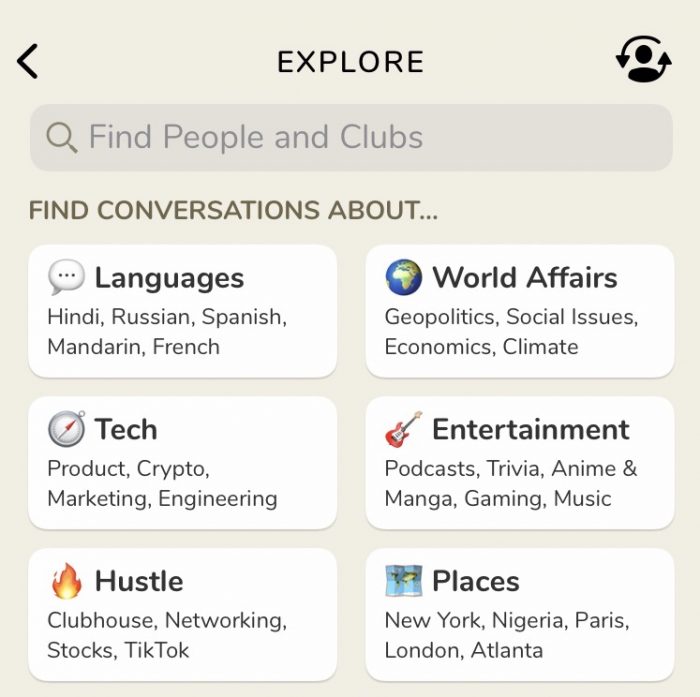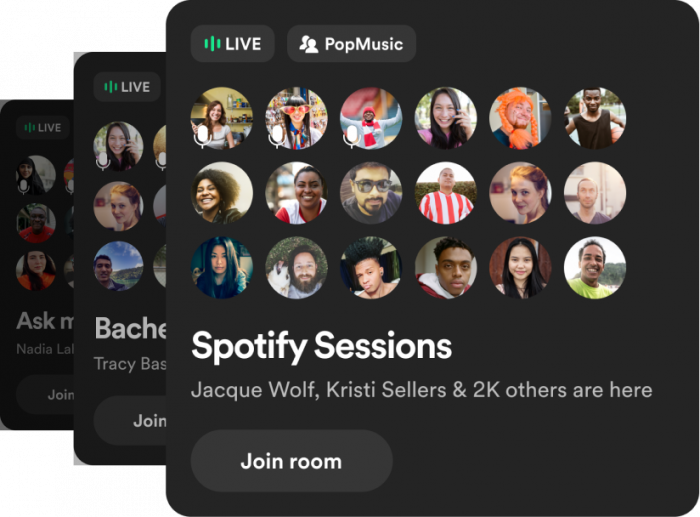You enter a social audio room and hear multiple voices discussing a trending topic.
You record yourself telling a story about your day and you share it with a friend.
In this article
- What Is Social Audio?
- Clubhouse
- Facebook’s audio creation tools
- Twitter Spaces
- Spotify Greenroom
- Social Audio: The Ultimate Channel for Our Touchless World
You sit in the virtual audience of a keynote speech and ask a question by speaking into your phone’s mic.
Sign Up for Free Today
Find the perfect voice for your job today, or sign up as a talent to start booking voice over work on Voices.
You bombard your followers with comical soundbites of your voice distorted in high and low pitches. You select an audio snippet from your favorite podcast and post it onto your feed.
These are but a few of the ways that new social audio products have given people the opportunity to connect with one another using the power of sound.
Until recently, the dominant social media platforms—such as Facebook, Twitter, Instagram, TikTok, Twitch, and Snapchat—have mainly used images, video, and text as a means for their users to create and share content.
In some instances, listening platforms like SoundCloud have allowed users to directly engage with audio content by leaving comments at certain points on a track’s timestamp. More often than not, however, audio has simply served as a secondary consideration meant to complement visual media—instead of standing on its own.
Now, audio is getting its moment in the spotlight.
In our age of remote work and social distancing, more people than ever are turning to social media to keep in touch with friends, stay informed about global events, and be entertained. At the same time, users have grown tired of staring at screens for long stretches.
The solution to the screen fatigue that we’re all experiencing? Voice-based social media.
From a trending invite-only audio app to existing social platforms that have set out to capitalize on the growing consumer interest in voice-based social experiences, audio has stepped up to the new frontier of social media—and it’s making a lot of ears perk up. But is social audio simply a flash in the pan? Or will it resonate for years to come?
Let’s take a look at the biggest media platforms that are making pioneering strides in the social audio space.
But first:
What Is Social Audio?
The terms ‘voice-based social media’ and ‘social audio’ refer to social media products that use audio as their primary means of communication. Social audio can include live conversation rooms, voice messaging, audio creation and editing tools, podcasts, and more.
Tech industry analyst Jeremiah Owyang calls social audio the ‘Goldilocks’ medium of the 2020s, because it “represents the opportunity for social connection and empathy without the downsides of video.”
The frictionless user experience that social audio fosters is the reason why many people already opt to listen to educational podcasts to learn new things, or use voice commands and smart speakers to initiate various tasks (from placing internet search queries to making lists). The nice thing about social audio is that it takes all the great aspects of consuming audio content and enables you to use audio technology to do more than just listen. Social audio allows you to interact with others.
Social audio is a relatively new subcategory of social media that is still in the process of finding its voice, meaning that there isn’t one standard type of social audio platform on the market. These apps are just apps to record a phone call, but rather a group discussion with features that allow people to raise hands, be promoted to a speaker or moderator and guide a group discussion for an entertaining group experience.
The following four channels have all decided to capitalize on the opportunity that social audio presents—while going about it in different ways. Content creators and brands will be keeping a close eye on these platforms to see where they advance the audio revolution to next.
Clubhouse
Clubhouse is an audio social network that facilitates group conversation through a series of voice chat rooms that users can drop into and listen in on. Created by Paul Davison and Rohan Seth, an invite-only version of the app was launched in March 2020, followed by a beta version for Android that was released in May 2021 and is now globally available.
In Clubhouse, users can speak to one another in virtual rooms. The three types of rooms include ‘open rooms,’ ‘social rooms,’ and ‘closed rooms.’
- Open rooms: anyone on Clubhouse can join
- Social rooms: users who follow a moderator are able to view and join that moderator’s room
- Closed rooms: the moderator may invites any user they would like to join in the chat
Rooms are where live conversations happen in Clubhouse. These rooms are housed within clubs, which users can follow or become members of.

You can search for clubs by topic. For example, if you’re interested in gaming, then you can search for clubs about gaming, spanning everything from Esports (which, at the time of writing, has 31.6k members) to Chess Club (8.5k members). If you’d like to converse with other Clubhouse users in your mother tongue, or if, for example, you’re trying to learn a new language, there are a multitude of clubs that you can join—like the Mandarin Learners Club (107k members) or Practice Your Spanish club (58.4k members).
Clubhouse is the first social platform where voice serves as the primary means of communication. This makes the app less hands-off and distracting than, say, scrolling through a typical social feed or watching video content. You can listen in on a chat happening inside a room while doing other things, like household chores.
The ephemerality of the conversations that happen in Clubhouse are a major contributor to what makes them so special. Conversations are not recorded, and you cannot send voice messages. Conversations in Clubhouse are live, and once they’re done, they’re done.
Clubhouse is still in its early stages and ironing out any kinks that may arise as users gradually acquaint themselves with the new voice-based platform. To promote user adoption of Clubhouse, the app has launched an accelerator program that grants the creators behind 50 audio shows a $5,000 per month stipend, in addition to gear and creative support.
Facebook’s audio creation tools
In spring of 2021, on the heels of the Clubhouse explosion, Facebook announced that it would begin to roll out new audio features for users that would be accessible directly within the Facebook app.
Among these features are in-app audio creation tools. “Through our advances in AI,” Facebook wrote in a press release, “we can make audio quality magically great — even if you record on a busy street corner.” These audio creation tools will enable users to add voice filters to morph their voices, or choose from tracks within the Facebook Sound Collection to serve as the soundtrack of a voice recording.
Another feature Facebook unveiled is in-app podcast listening and discovery tools, which will allow users to listen to podcasts in the Facebook app, even when the app is backgrounded. Facebook also said that, with its new audio products, “creators will be able to turn a live conversation into a podcast for everyone to listen to later.”
Facebook is further following in the footsteps of Clubhouse by launching Live Audio Rooms. Groups on Facebook will be able to host live chat rooms where members of that group can take part in real-time voice discussions with one another.
“Fans will be able to support their favorite creators and public figures through Stars,” Facebook said about their Live Audio Rooms. “We’ll also offer other monetization models, like the ability to charge for access to a Live Audio Room through a single purchase or a subscription.”
Facebook’s monetized audio rooms mark a noticeable departure from the likes of Clubhouse, which hasn’t yet explored any tools for creators to charge users to join clubs or take part in certain rooms.
Twitter Spaces
Much like Facebook, Twitter is expanding upon its longstanding reputation as a social media giant by moving into the realm of social audio.
In fact, Twitter was ahead of the game by branching into audio back in June 2020 when they first launched the voice tweet feature.
Now, with Twitter Spaces, anybody with a Twitter account and more than 600 followers will be able to host a conversation. Anyone who follows the account that hosts a space, or who has been sent the conversation’s link, will be able to join in on that conversation.
Users are able to take part in the conversation and access their Twitter feed simultaneously, so they won’t have to put a pause on scrolling through their feed to access Twitter’s audio features.
Another exciting detail of Twitter Spaces is that it will allow for a user’s speech to be captioned with live subtitles.
Beyond Twitter’s Spaces offering, the service has also announced that it will be rolling out a feature entitled Ticketed Spaces, which will allow users with more than 1,000 followers to charge for admission into a live conversation. Users will be able to keep up to 80% of the revenue from the tickets sold as part of Ticketed Spaces.
Spotify Greenroom
Just as social media giants Facebook and Twitter have recently developed audio tools in an attempt to compete with Clubhouse and tap into emerging social listening habits, a different company has newly begun to break into the social audio space: Spotify.
Spotify has been working to establish itself as a leader in audio for some time now. Until recently, that meant shaping itself into the go-to service for music listeners, as well as working with some of the industry’s biggest podcast networks and creators to position itself as a leader in podcasting.
Now, with Spotify Greenroom, the Swedish streaming service has taken their stake in audio to the next level.

Greenroom is a live audio-only app “that allows artists and other creators to connect with fans, followers, and friends in the moment.” Much like Clubhouse or Twitter Spaces, Greenroom involves hosting discussions through what the app is currently calling ‘rooms’ and ‘spaces.’
These discussions, or Sessions, enable artists and creators to talk about their newest releases on Spotify, host an after-party to chat more intimately with fans following a virtual event or live show, take a deep dive into your discography, or chat with other content creators.
Social Audio: The Ultimate Channel for Our Touchless World
In a world where screen fatigue has set in and people are looking for new and enriching ways to use technology to engage with friends, family, and communities around the world, social audio and voice-based social media have emerged as a beneficial alternative to traditional screen-based social media.
The human voice is one of the most intimate tools that we have to relate with other people. With social audio, users can speak out and share their stories with the world, while feeling as closely connected as if they are in the same room with the users they’re talking to.
As social audio continues to take off, brands and creators will both be looking for ways to capitalize on this new medium to reach their audiences where they are. At the time of writing, Clubhouse, Facebook, Twitter, and Spotify appear to be the companies that are putting the most stake in audio, but there is no question that other social media platforms are taking note and will begin to roll out their own versions of social audio products in the near future.
If you’re looking for a voice for your social audio content or an audio expert to elevate your sonic branding to the next level, then you’ve come to the right place. On Voices, you can hire professional talent in an array of creative categories in order to amplify your professional output and strike a chord with your audience.
Sign up for a Voices account to get started.

Comments
Nice blog